
A | B | C | D | E | F | G | H | CH | I | J | K | L | M | N | O | P | Q | R | S | T | U | V | W | X | Y | Z | 0 | 1 | 2 | 3 | 4 | 5 | 6 | 7 | 8 | 9

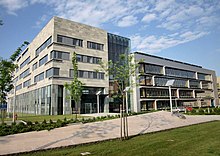

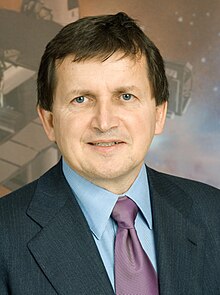
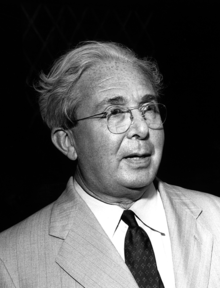


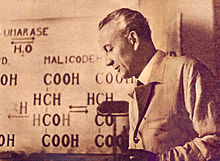
Science and technology is one of Hungary's most developed sectors.[2] The country spent 1.4% of its gross domestic product (GDP) on civil research and development in 2015, which is the 25th-highest ratio in the world.[3] Hungary ranks 32nd among the most innovative countries in the Bloomberg Innovation Index, standing before Hong Kong, Iceland or Malta.[4] Hungary was ranked 35th in the Global Innovation Index in 2023.[5]
In 2014, Hungary counted 2,651 full-time-equivalent researchers per million inhabitants, steadily increasing from 2,131 in 2010 and compares with 3,984 in the US or 4,380 in Germany.[6] Hungary's high technology industry has benefited from both the country's skilled workforce and the strong presence of foreign high-tech firms and research centres. Hungary also has one of the highest rates of filed patents, the 6th highest ratio of high-tech and medium high-tech output in the total industrial output, the 12th-highest research FDI inflow, placed 14th in research talent in business enterprise and has the 17th-best overall innovation efficiency ratio in the world.[7]
The key actor of research and development in Hungary is the National Research, Development and Innovation Office (NRDI Office), which is a national strategic and funding agency for scientific research, development and innovation, the primary source of advice on RDI policy for the Hungarian government, and the primary RDI funding agency. Its role is to develop RDI policy and ensure that Hungary adequately invest in RDI by funding excellent research and supporting innovation to increase competitiveness and to prepare the RDI strategy of the Hungarian Government, to handle the National Research, Development and Innovation Fund, and represents the Hungarian Government and a Hungarian RDI community in international organizations.[8]
The Hungarian Academy of Sciences and its research network is another key player in Hungarian R&D and it is the most important and prestigious learned society of Hungary, with the main responsibilities of the cultivation of science, dissemination of scientific findings, supporting research and development and representing Hungarian science domestically and around the world.[9]
Research universities and institutions
A mining school called "Berg Schola", the world's first institute of technology was founded in Selmecbánya, Kingdom of Hungary[10] (today Banská Štiavnica, Slovakia), in 1735. Its legal successor is the University of Miskolc and the University of Sopron in Hungary.
BME University is considered the world's oldest institute of technology which has university rank and structure. It was the first institute in Europe to train engineers at university level.[11]
Among Hungary's numerous research universities, the Eötvös Loránd University, founded in 1635, is one of the largest and the most prestigious[12] public higher education institutions in Hungary. The 28,000 students at ELTE are organized into eight faculties, and into research institutes located throughout Budapest. ELTE is affiliated with 5 Nobel laureates, as well as winners of the Wolf Prize, Fulkerson Prize and Abel Prize, the latest of which was Abel Prize winner Endre Szemerédi in 2012.
Semmelweis University in the recently released QS World University Rankings 2016 listed among the world's best 151-200 universities in the categories of medicine and pharmacy. According to the international ranking in the field of medicine Semmelweis University ranked first among the Hungarian universities. The "Modern Medical Technologies at Semmelweis University" project ensuring institution's place among the leading research universities in four main areas: Personalised medicine; Imaging processes and bioimaging: from molecule to the human being; Bio-engineering and nanomedicine; Molecular medicine.
Budapest University of Technology and Economics's research activities encouraged and is present on all levels from the B.Sc. through to the doctoral level. During the 1980s the BUTE was among the first in the Eastern bloc to recognise the importance of participating in research activities with institutions in Western Europe. Consequently, the university has the most well-established research relationships with Western European universities. There are many famous alumni at university: Dennis Gabor who was the inventor of holography got his Nobel Prize in Physics in 1971, George Oláh got his Nobel Prize in Chemistry in 1994. Nowadays the university has 110 departments, 1100 lecturers, 400 researchers.
University of Szeged internationally acknowledged, competitive research activities are essential parts of its educational mission, and it is particularly important to ensure the institution's position as a research university. Its research and creative activities include basic and applied research, creative arts, product and service development. University of Debrecen with a student body of about 30 thousand is one of the largest institutions of higher education in Hungary and its priority areas of research include: molecular science; physical, computational and material science; medical, health, environmental and agricultural science; linguistics, culture and bioethics. University of Pécs is one of the leading research universities in the country with a huge professional research background. The Szentágothai Research Centre of the University of Pécs is covers all aspects of education, research and innovation in the fields of biomedical, natural and environmental sciences. The infrastructure, instrumentation and expertise of the 22 research groups operating on the premises provide an excellent basis to become a well-known, leading research facility in Hungary as well as in Central Europe with an extensive and fruitful collaboration network.
Hungarian Academy of Sciences's research network also contributes significantly to research output of Hungary. It comprises 15 legally independent research institutions and more than 130 research groups at universities co-financed by the academy. This research network focusing above all on discovery research is unparalleled in Hungary, accounting for one-third of all scientific publications produced in the country. Citation indices of publications posted by the academy's researchers surpass the Hungarian average by 25.5%. The research network addresses discovery and targeted research, in cooperation with universities and corporations. The main components of the network are the MTA Szeged Research Centre for Biology, the MTA Institute for Computer Science and Control, the MTA Rényi Institute of Mathematics, the MTA Research Centre for Natural Sciences, the MTA Institute of Nuclear Research, the MTA Institute of Experimental Medicine, MTA Wigner Research Centre for Physics, the MTA Centre for Energy Research and MTA Research Centre for Astronomy and Earth Sciences (involved with Konkoly Observatory).[13]
Venture capital market
According to the HVCA (Hungarian Venture Capital and Private Equity Association) report joint efforts of the venture capital and private equity industry and the Hungarian government, the access of Hungarian enterprises to venture capital and private equity funding could be significantly increased. During the past two decades these financial intermediaries have also played an increasingly important role in the Hungarian economy. During this period, venture capital and private equity funds invested close to 4 billion US Dollars into more than 400 Hungarian enterprises.
However, so-called buyout transactions have accounted for about two thirds of the total volume of those investments, which were aimed at the acquisition of shares in mature companies that have been operating profitably for several years. The volume of investments in early and expansive stage companies was significantly lower. Only about 30% of the total volume of investments was directed at companies in the expansive stage and less than 5% at early stage companies. This is also reflected by the fact that over the last two decades slightly more than 10% of the total volume of venture capital and private equity investments came from funds focusing on early stage companies. The remaining close to 90% was invested by private equity funds focusing on more mature companies with greater economic strength. As for the number of transactions, companies in the expansive stage were targeted by the largest number of venture capital and private equity investments: such investments accounted for almost 60% of Hungarian transactions. Nearly a third of transactions involved early stage companies. Buy-out deals represented approximately 10% of transactions by number. Several factors have contributed to this growth. These include tax exemptions on Hungarian venture capital, funds established in conjunction with large international banks and financial companies and the involvement of major organizations desirous to capitalize on the strengths of Hungarian start up and high-tech companies. In recent years, the share of venture capital invested in the growth stages of enterprises has flourished at the expense of early stage investments.[14]
Nobel Prize laureates
Since the first Hungarian won a Nobel Prize in 1905, the country has added a further 14 to its cache.[15] With scientists, writers and economists all honored in the prestigious awards:
| Year | Winner | Field | Contribution |
|---|---|---|---|
| 1905 | Philipp Lenard | Physics | "for his work on cathode rays" |
| 1914 | Robert Bárány | Medicine | "for his work on the physiology and pathology of the vestibular apparatus" |
| 1925 | Richard Adolf Zsigmondy | Chemistry | "for his demonstration of the heterogeneous nature of colloid solutions and for the methods he used, which have since become fundamental in modern colloid chemistry" |
| 1937 | Albert Szent-Györgyi | Medicine | "for his discoveries in connection with the biological combustion processes, with special reference to vitamin C and the catalysis of fumaric acid" |
| 1943 | George de Hevesy | Chemistry | "for his work on the use of isotopes as tracers in the study of chemical processes" |
| 1961 | Georg von Békésy | Medicine | "for his discoveries of the physical mechanism of stimulation within the cochlea" |
| 1963 | Eugene Wigner | Physics | "for his contributions to the theory of the atomic nucleus and the elementary particles, particularly through the discovery and application of fundamental symmetry principles" |
| 1971 | Dennis Gabor | Physics | "for his invention and development of the holographic method" |
| 1986 | John Polanyi | Chemistry | "for their contributions concerning the dynamics of chemical elementary processes" |
| 1994 | George Olah | Chemistry | "for his contribution to carbocation chemistry" |
| 1994 | John Harsanyi | Economics | "pioneering analysis of equilibria in the theory of non-cooperative games" |
| 2002 | Imre Kertész | Literature | "for writing that upholds the fragile experience of the individual against the barbaric arbitrariness of history" |
| 2004 | Avram Hershko | Chemistry | "for the discovery of ubiquitin-mediated protein degradation" |
| 2023 | Katalin Karikó | Medicine | "for the development of mRNA-based vaccine" |
| 2023 | Ferenc Krausz[16] | Physics | "for experimental methods that generate attosecond pulses of light for the study of electron dynamics in matter" |
Hungarian Scientific Olympic Achievements
Hungary has excelled at the scientific Olympiads, ever since the beginnings. Best result is in maths with absolute cumulative 4th place until 2019, behind China, Russia and US. Per capita result is a world leader.[17] Results in physics is just somewhat weaker. 9th place (3rd best in Europe). Per capita result is also a world leader. Chemistry (1968-2019) results give 8th place and 4th place in Europe. This is also a world leader per capita. However the results have weakened lately.
Hungarian inventions
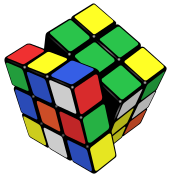
- The English word "coach" came from the Hungarian kocsi ("wagon from Kocs" referring to the village in Hungary where coaches were first made).[18][19]
- Wolfgang von Kempelen invented a manually operated speaking machine in 1769.
- János Irinyi invented the noiseless match.
- In 1827, Ányos Jedlik invented an early electric motor. He created the first device to contain the three main components of practical direct current motors: the stator, rotor and commutator. He built the first generator which used, instead of permanent magnets, two electromagnets opposite to each other to induce the magnetic field around the rotor. This was also the discovery of the principle of "dynamo self-excitation".
- David Schwarz invented and designed the first flyable rigid airship (aluminium-made). Later, he sold his patent to German Graf Zeppelin, who built the so-called Zeppelin airship.
- Donát Bánki and János Csonka invented the carburetor.
- Ottó Bláthy, Miksa Déri and Károly Zipernowsky invented the modern transformer in 1885.[20]
- Ottó Bláthy invented the turbogenerator and wattmeter.
- Kálmán Kandó invented the three-phase alternating current electric locomotive, and was a pioneer in the development of electric railway traction.
- Tivadar Puskás invented the telephone exchange, Telefon Hírmondó.
- Dezső Korda invented the rotating capacitor (tuning capacitor).
- József Galamb was the main engineer and inventor of the Ford Model T and co-developer of the assembly line.
- Eugene Farkas was main engineer on the Fordson tractor.
- Sándor Just invented the tungsten electric bulb (1904).
- Imre Bródy invented the krypton electric bulb.
- Loránd Eötvös: weak equivalence principle and surface tension.
- Sándor Gaál invented the cyclotrone 1929 (but the German editorial, registered 5th of may, mistok it, and did not publish the study)
- Kálmán Tihanyi invented and described the "charge-storage" physical phenomenon, was a pioneer in developing the electronic television and camera-tube (1926), and invented the plasma TV (1936) and infrared camera (1929).
- István Juhász Gamma-Juhász predictor (electro-mechanical "computer") 1930 used for directing artillery.
- Jenö Dulovits 1st mirror-reflex-camera:Duflex
- József Mihályi (Chief-designer at Kodak) was co-designer or designer and inventor for Kodak of the following cameras: Kodak Ekstra, Kodak Medalist, Kodak Super Six-20[21] and Kodak Bantam Special.[22]
- Ödön Riszdorfer and 0Mihályi invented the first semi-automatic camera: Kodak Super Six-20
- Ödön Riszdorfer light meter (1931)
- Béla Barényi designed the Volkswagen Beetle and is the father of passive safety in automobiles.
- Ervin Kováts invented the concept of Kovats retention index, a concept used in gas chromatography.
- Csaba Horváth constructed the first high performance liquid chromatograph.
- Ferenc Anisits invented the modern diesel engine.
- Albert Szent-Györgyi discovered Vitamin C and created the first artificial vitamin. (Nobel Prize in Physiology or Medicine in 1937)
- Theodore Kármán – Mathematical tools to study fluid flow and mathematical background of supersonic flight and inventor of swept-back wings, "father of Supersonic Flight".
- Albert Fonó invented ramjet propulsion.
- György Jendrassik invented turboprop propulsion.
- Leó Szilárd hypothesized the nuclear chain reaction invented and patented the atomic bomb (1934), co-patented the nuclear reactor, invented the electron microscope and the linear accelerator (the first particle accelerator), and later invented the cyclotron.[23]
- Tamás Péter Bródy invented the active-matrix thin film transistor technology which underpins the LCD and OLED displays commonly used today.
- Dennis Gabor invented holography (Nobel Prize in Physics in 1971).
- László Bíró invented the ballpoint pen.
- Edward Teller hypothesized thermonuclear fusion and the theory of the hydrogen bomb.
- John Kemeny developed the BASIC programming language with Thomas E. Kurtz.
- Ferenc Pavlics was one of two co-developers of the NASA Apollo Lunar rover.
- Antal K. Bejczy developed Mars Rover Sojourner.
- Ernő Rubik invented the so-called Rubik's Cube.
- ArchiCAD 3-D software was developed by Gábor Bojár (1987).
- Charles Simonyi was chief-architect at Microsoft and oversaw the creation of Microsoft's flagship Office suite of applications.[24][25]
- Gömböc, a new geometrical body, was invented in 2006 by Hungarian scientists Gábor Domokos and Péter Várkonyi.
- Endre Mester invented low level laser therapy, also known as "light therapy".
- Prezi, a web-based presentation application and storytelling tool, developed by Adam Somlai-Fischer and Peter Halacsy in 2007.
- Áron Losonczy invented the LiTraCon, a translucent concrete building material.
- Dániel Rátai invented the three-dimensional monitor: Leonar3Do.[26]
- The three-dimensional scanner microscope 3D Alba (international patent in 2007) was developed by Katona Gergely and Rózsa Balázs.[27]
In August 1939, Szilárd approached his old friend and collaborator Albert Einstein and convinced him to sign the Einstein–Szilárd letter, lending the weight of Einstein's fame to the proposal. The letter led directly to the establishment of research into nuclear fission by the U.S. government and ultimately to the creation of the Manhattan Project. (Szilárd, with Enrico Fermi, patented the nuclear reactor).
Science
Scientists and inventors
Important names in the 18th century are Maximilian Hell (astronomer), János Sajnovics (linguist), Matthias Bel (polyhistor), Sámuel Mikoviny (engineer) and Wolfgang von Kempelen (polyhistor and co-founder of comparative linguistics). Physicist and engineer Ányos Jedlik invented the first electric motor (1828), the dynamo, self-excitation, the impulse generator, and the cascade connection of capacitors. An important name in 19th-century physics is Joseph Petzval, one of the founders of modern optics. The invention of the transformer (by Ottó Bláthy, Miksa Déri and Károly Zipernowsky), the AC electricity meter, and electricity distribution systems with parallel-connected power sources decided the future of electrification in the war of the currents, which resulted in the global triumph of alternating current systems over the earlier direct current systems. Roland von Eötvös discovered the weak equivalence principle (one of the cornerstones in Einsteinian relativity). Radó von Kövesligethy discovered laws of black-body radiation before Planck and Wien.[28][29]
Hungary is famous for its excellent mathematics education, which has trained numerous outstanding scientists. Famous Hungarian mathematicians include father Farkas Bolyai and son János Bolyai, designer of modern geometry (non-Euclidean geometry) 1820–1823. Together with John von Neumann, János Bolyai is considered to be the greatest Hungarian mathematician ever. The most prestigious Hungarian scientific award is named in honor of János Bolyai. John von Neumann was a pioneer in quantum theory, game theory and digital computing, and he was the key mathematician on the Manhattan Project. Mathematician Paul Erdős is famed for publishing in over forty languages, and his Erdős numbers are still tracked.[30]
Many Hungarian scientists, including Zoltán Bay, Victor Szebehely (practical solution to the three-body problem; Newton the two-body problem), Mária Telkes, Imre Izsak, Louis W. Parker, Erdős, von Neumann, Leó Szilárd, Eugene Wigner, Theodore von Kármán and Edward Teller, emigrated to the United States and made valuable contributions there. (Some Hungarian scientists went to Germany instead: engineer/scientist István Szabó (1906-1980), for example.[31] (Some went to Soviet Union:Robert Bartini). István Juhász, inventor of one of the earliest electro-mechanical computers, Gamma-Juhász,[32][33] stayed at home and was ostracized) An influential cause of scientist emigration was the 1920 Treaty of Trianon after World War I, by which Hungary, diminished by the treaty, became unable to support large-scale, costly scientific research. At least fifteen (15-20) Hungarian or Hungarian-born scientists received the Nobel Prize: von Lenárd, Bárány, Zsigmondy, von Szent-Györgyi, de Hevesy, von Békésy, Wigner, Gábor, Polányi, Oláh, Harsányi,Herskó and in 2023: Katalin Karikó and Ferenc Krausz. Most of them had emigrated, mostly because of persecution by communist and/or fascist regimes.[citation needed] A significant group of Hungarian dissident scientists of Jewish descent who settled in the United States in the first half of the 20th century were called The Martians.[34]
Béla Gáspár patented the first one-strip fullcolor film: Gasparcolor. Names in psychology are János Selye founder of Stress-theory and Csikszentmihalyi founder of Flow- theory. Tamás Roska is co-inventor of CNN (cellular neural network).
Some internationally well-known figures of today include: mathematician László Lovász, physicist Albert-László Barabási, physicist Ferenc Krausz, chemist Julius Rebek, chemist Árpád Furka, biochemist Árpád Pusztai and the highly controversial former NASA-physicist Ferenc Miskolczi, who denies the green-house effect.[35] According to Science Watch: In Hadron research Hungary has most citations per paper in the world.[36] In 2011 neuroscientists György Buzsáki, Tamás Freund and Peter Somogyi were awarded with The Brain Prize ("Danish Nobel Prize" in neurology)" for "brain circuits involved in memory".[37] Péter Horváth,[38] in Szeged, is a biophysicist, explaining minimal changes in a cell.
After the fall of the communist dictatorship (1989), a new scientific prize, the János Bolyai Creative Award (Bolyai János alkotói díj), was established (1997), politically unbiased and of the highest international standard. Tibor Gánti got full recognition first after his death for his Chemoton-theory which explains how life started.
Events with Awards since 2000
| Year | Events | ||
|---|---|---|---|
| 2001 | chemist
Csaba Horváth |
Separation Science and Technology Award | "father of HPLC" |
| 2001 | chemist | National Medal of Science
As 11th hungarian |
1st Theodore von Kármán (1962) 2nd Eugene Wigner (1968) 3rd Edward Teller (1984) |
| 2002 | physicist | Wittgenstein Prize | |
| 2003 | chemist Tibor Gánti | Chemoton | The Principles of Life (Oxford pUniversity Press - 2003) |
| 2004 | chemist Zoltan Nusser | Lieben Prize Austrian prize to former Austro-Hungarian lands. | as 1st hungarian since 2004 |
| 2004 | chemist | Nobel Prize | chemistry: as 7th hungarian |
| 2005 | mathematician
Peter Lax (US) |
Abel prize 1st hungarian | |
| 2006 | mathematician
Gábor Domokos and Péter Várkonyi |
created a new geometrical shape: Gömböc | |
| 2008 | mathematician | C&C prize.[39][circular reference] | |
| 2008 | physicist | National Medal of Science (US) As 11th? hungarian |
5th: Paul Gyorgyi 75 6th:Peter C. Goldmark 76 7th:Lax 86 8th:Bott 87 9th:Stigler 87 10th: Friedman 88 |
| 2009 | physicist
(US) |
James Clerk Maxwell Prize for Plasma Physics 1st hungarian | |
| 2009 | neuroscientist Peter Somogyi | Feldberg Foundation
2nd hungarian 1st György Radda | |
| 2009 | chemist Csaba Pal | Lieben Prize | as 2nd hungarian since 2004 |
| 2010 | mathematician | Kyoto Prize | as 3rd hungarian
1st Rudolf Kálmán 2nd György Ligeti |
| 2011 | chemist
Julius Rebek (US) |
William H. Nichols Medal 1st hung. | |
| 2011 | neuroscientists
György Buzsáki (US), Peter Somogyi (UK) & Tamas Freund |
Inaugural European Brain Award (Dk) | |
| 2012 | mathematician | Abel prize | 2nd hung. |
| 2012 | mathematician
László Lovász won the |
Fulkersson prize | (2nd time) |
| 2013 | physicist
Miklos Porkolab (US) |
Hannes Alfvén Prize | 1st hung. |
| 2013 | physicist | Otto Hahn Prize | |
| 2013 | mathematician | Claude E. Shannon Award | 2nd hung.
1st:Imre Cziszár |
| 2019 | mathematician | Claude E. Shannon Award | 3rd hung. |
| 2015 | physicist | Thomson Reuters Citation Laureate | |
| 2015 | physicist | might have found the Fifth force | |
| 2015 | chemist | William H. Nichols Medal | 2nd hung. |
| 2016 | mathematician Illes Farkas | Lieben Prize | as 4th hungarian since 2004 |
| 2017 | mathematician | Shaw prize | |
| 2017 | mathematician | Bôcher prize | 2nd hung.
1st: John von Neumann |
